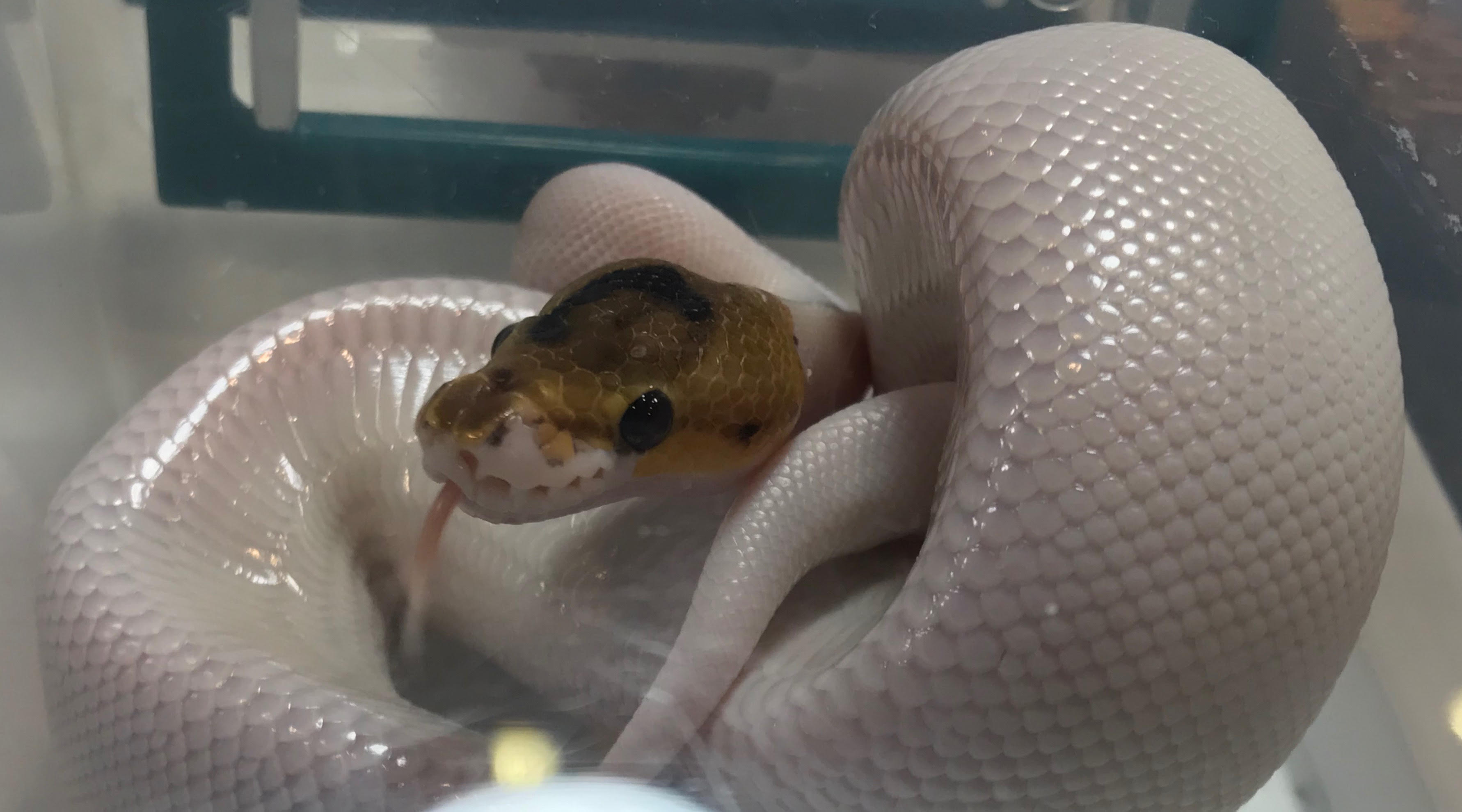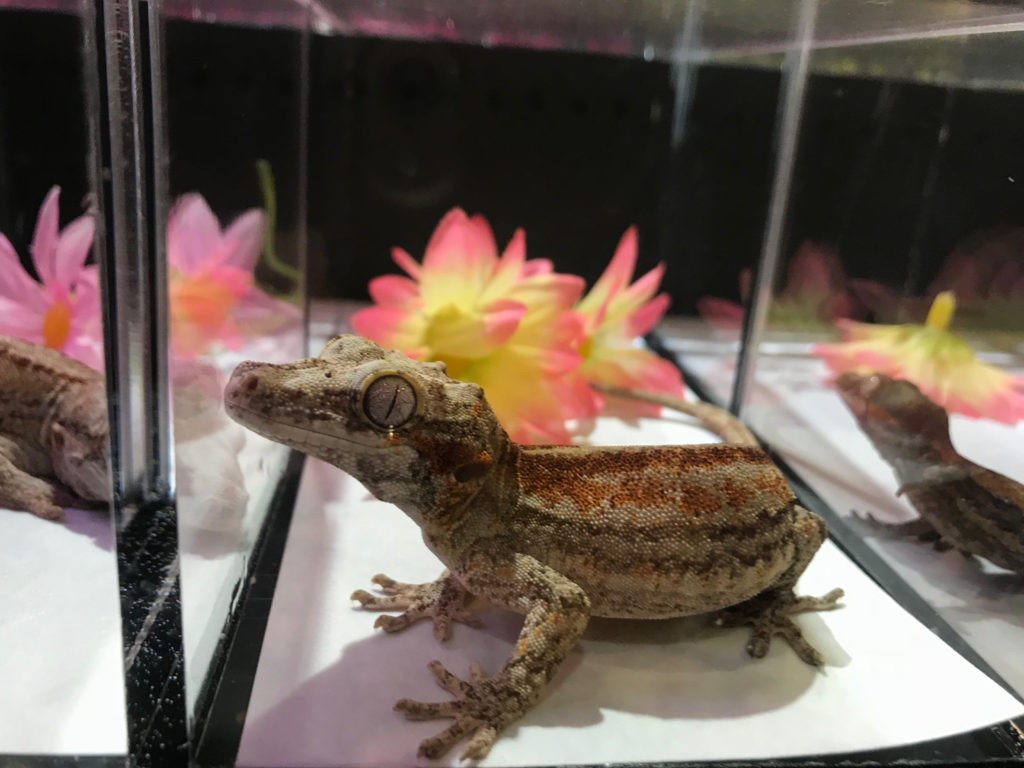It was a wet Sunday afternoon, and the parking lot outside the Westchester County Center was nearly full. Fog cut off the tips of the buildings. Groups of people of all ages and backgrounds were returning to their cars, carrying glass tanks of all sizes under towels and umbrellas. A man carrying a tank with a 20-pound tortoise exited the main entrance of the center as little kids looked on with awe.
Despite the bad weather, nearly 200 people lined up along the grand steps underneath 60-foot white pillars. They were all here for the New York Metro Reptile Expo.
Bruce Lowder, owner of Animal Encounters, in Putnam Valley, New York, started the reptile exposition in 1992 as a fundraiser for the nature center he worked for at the time. The first event had just 18 vendor tables.
“We expected only around a hundred people,” Lowder said. “But more than 900 showed up.”
Today, the White Plains expo averages 5,000 attendees at each event, with those in the winter months being the most popular, he said.
At the expo’s prime time, around 12:30 p.m., the center was nearly at capacity. People eagerly inched toward the entrance, waiting to receive an entrance stamp on the back of their hands of a small black turtle.
Once inside, the smell of popcorn wafted through the air. The sound of crickets chirping could be heard underneath the incoherent white noise from all the humans. There were people and tables with tanks everywhere. Each table had an array of animals — tarantulas, candy-colored frogs, insects, lizards, crabs, geckos, turtles and snakes, which were mostly ball pythons.

Historically, snakes have always been the most popular animals at the show, though in recent years the expo has seen a lot more lizard breeders, particularly of geckos, Lowder said.
“It’s great to see how the hobby has flourished over the years, drawing together a hugely diverse group of people to share in their love of a common hobby,” he said.
Along with the reptiles, amphibians and insects for sale, the expo also featured prey items. The occasional table emitted the pungent odor of insects. Bin after bin was filled with thousands of crickets, cockroaches, coconut hookworms and hornworms. Two tables had freezers stocked with rats and mice. Pets and prey were laid out side by side, awaiting their purchasers.
One table even had live rat pups for sale, their red pulpy bodies squirming under a heating lamp.
There was a bit of an alt-grunge vibe from both the crowd and vendors. Many were heavily clad in tattoos and piercings, wearing metal band T-shirts with colored hair. The vendors come from all over the tristate area, some as far as Virginia and Ohio. The event also attracted families and groups of friends of all ages.
People surrounded each table. Some came for the experience, but most were passionate hobbyists seeking the latest snake morph.
A morph is the result of a mutated gene on a strand of DNA in an animal’s chromosome that causes a variation in coloration or pattern. Over time, breeding for the desired dominant or recessive gene will predictably create the abnormality.
Some morphs sought after include spider morphs, which dilute the python’s patterns into thinner lines, and pastels, which lighten up the scales
“It seems that the explosion of ball python morphs has really caught the fancy of many snake breeders,” Lowder said.
Dan Sullivan, 25, from White Plains, New York, has been keeping snakes since he was a young boy. Expos provide people with a hands-on experience that they wouldn’t normally get from a pet store or through an online purchase, Sullivan said.
“Being able to speak face to face with vendors allows me to see if they’re exaggerating the uniqueness of their python morph,” he said. “Many vendors act like any other salesmen, using any tactic to convince you that their product is the best.”
A 65-year-old turtle breeder from Maryland, who requested to remain anonymous and go by Tom, boasted about the large sales volume he had at the event. Tom has been breeding turtles for 25 years, and he currently has over 300 turtles in his home, which is being renovated to accommodate a fully-equipped breeding facility, he said.
Tom emphasized that had he made his “thousand bucks” and would be leaving the expo with only two remaining turtles. He leaned in and said that three of the turtles he had sold today were illegal to sell in New York.
“Security told me I had to get them off my table now,” he said with a laugh.
“So I sold them. I got them off the table, didn’t I?”
The turtle he sold was a bog turtle, a species native to New York. It is illegal in New York to buy, sell, transport or have in possession any native reptile protected by law.
Despite growing up in Rockland County, New York, Tom chose to sell the native species anyway. Though Tom may be a passionate breeder, his choice of action raises ethical concerns. Where he originally purchased the bog turtle was also unclear.
To protect animals from irresponsible owners and breeders, many laws have been put in place. The Convention on International Trade in Endangered Species of Wild Fauna and Flora (CITES) is a treaty that protects listed animals from exploitation due to international trade. Along with CITES, The Lacey Act of 1900, is a United States conservation law that prohibits the trade of wildlife that has been illegally taken, possessed, transported or sold.
With the exception of breeders like Tom, the majority of small-time private breeders appeared to abide by the rules and sell for the joy of it, not the profit.
Mike Curtin, 40, sole proprietor of Scattershot Exotics in New Jersey, has been in the industry for over 10 years. Curtin specializes in Australian pythons, but also breeds Argentine boas.
“In any industry, there’s gonna be the good and the bad guys,” he said.
“The problem with most high-volume or multi-species vendors is that they are not always focused on the long-term health of individual animals,” he said. “They are looking to have a high turnover rate, investing as little as possible into each animal.”
High-volume vendors don’t have the ability to test every animal, and their employees seldom know how to properly care for exotics, he said.
Many part-time breeders don’t rely on breeding as their main source of income, Curtin said. They are more often a part of the industry for the reward of raising the animals they’re passionate about and interacting within the reptile community.
Like many of the breeders at the NY Reptile Expo, Curtin recalled childhood as the time he began raising reptiles.
“I’ve been keeping reptiles ever since I could catch critters at the local pond to bring home.”





Comments are closed.